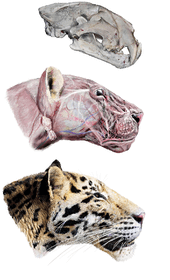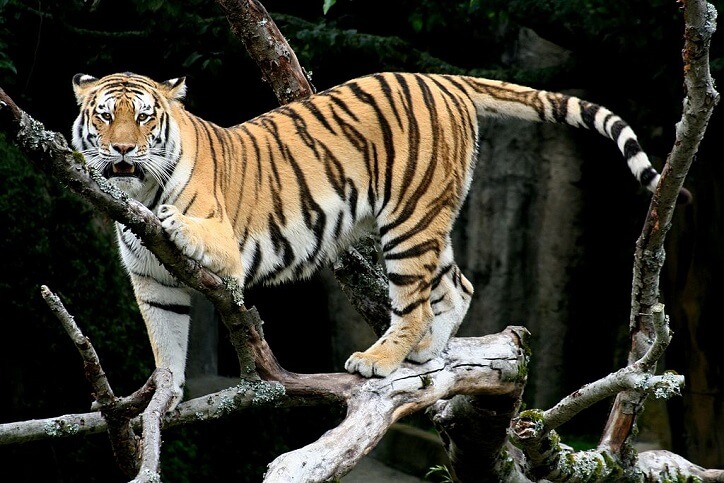The tiger’s closest living relatives were previously thought to be the Panthera species lion, leopard and jaguar. Results of genetic analysis indicate that about 2.88 million years ago, the tiger and the snow leopard lineages diverged from the other Panthera species, and that both may be more closely related to each other than to the lion, leopard and jaguar. The geographic origin of the Panthera is most likely northern Central Asia. The tiger–snow leopard lineage dispersed in Southeast Asia during the Miocene.
 Panthera zdanskyi is considered to be a sister taxon of the modern tiger. It lived at the beginning of the Pleistocene about two million years ago, its fossil remains were excavated in Gansu province of northwestern China. It is considered to have been more “primitive”, but functionally and ecologically similar to the modern tiger. Northwestern China is thought to be the origin of the tiger lineage. Tigers grew in size, possibly in response to adaptive radiations of prey species like deer and bovids, which may have occurred in Southeast Asia during the Early Pleistocene.
Panthera zdanskyi is considered to be a sister taxon of the modern tiger. It lived at the beginning of the Pleistocene about two million years ago, its fossil remains were excavated in Gansu province of northwestern China. It is considered to have been more “primitive”, but functionally and ecologically similar to the modern tiger. Northwestern China is thought to be the origin of the tiger lineage. Tigers grew in size, possibly in response to adaptive radiations of prey species like deer and bovids, which may have occurred in Southeast Asia during the Early Pleistocene.
Panthera tigris trinilensis lived about 1.2 million years ago and is known from fossils excavated near Trinil in Java. The Wanhsien, Ngandong, Trinil and Japanese tigers became extinct in prehistoric times. Tigers reached India and northern Asia in the late Pleistocene, reaching eastern Beringia, Japan, and Sakhalin. Some fossil skulls are morphologically distinct from lion skulls, which could indicate tiger presence in Alaska during the last glacial period, about 100,000 years ago.
In the Philippine island of Palawan, two articulated phalanx bones were found amidst an assemblage of other animal bones and stone tools in Ille Cave near the village of New Ibajay. They were smaller than mainland tiger fossils, possibly due to insular dwarfism. Otherwise, it would appear that early humans had accumulated the bones, so it may be that the tiger parts were imported from elsewhere, or that the tiger colonised Palawan from Borneo before the Holocene, considering the proximity of the two islands. Fossil remains of tigers were also excavated in Sri Lanka, China, Japan and Sarawak (Malaysia) dating to the late Pliocene, Pleistocene and Early Holocene. The Bornean tiger was apparently present in Borneo between the Late Pleistocene and the Holocene, but whether it went extinct in prehistoric or recent times has not been resolved.
The potential tiger range during the Late Pleistocene and Holocene was predicted applying ecological niche modelling based on more than 500 tiger locality records combined with bioclimatic data. The resulting model shows a contiguous tiger range from southern India to Siberia at the Last Glacial Maximum, indicating an unobstructed gene flow between tiger populations in mainland Asia throughout the Late Pleistocene and Holocene. The tiger populations on the Sunda Islands and mainland Asia were possibly separated during interglacial periods. Results of a phylogeographic study indicate that all living tigers had a common ancestor 72,000–108,000 years ago. The tiger’s full genome sequence was published in 2013. It was found to have similar repeat composition to other cat genomes and an appreciably conserved synteny.











